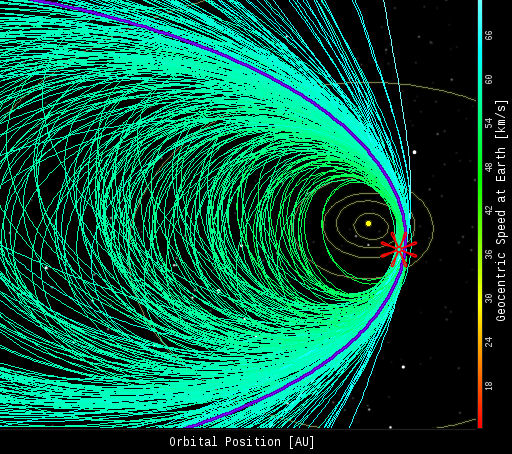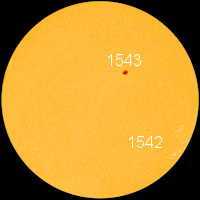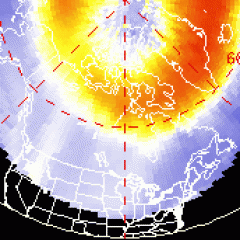~Space Weather Update~ Slight Chance For Flares~ [1]
SLIGHT CHANCE OF FLARES: NOAA forecasters estimate a 15% chance of M-class [2] solar flares today. Sunspot AR1543 has a 'beta-gamma' magnetic field that harbors energy for such eruptions. Solar Flare alerts: text [3], phone [4].
PERSEID RECAP: Earth is exiting the debris stream of Comet Swift-Tuttle, source of the annual Perseid meteor shower. According to the International Meteor Organization, the shower peaked on August 12th with ~120 meteors per hour. NASA's network of all-sky meteor cameras [5] photographed and measured the orbits of nearly 300 Perseid fireballs:
In the diagram, above, the location of Earth is denoted by a red splat. The orbit of parent comet Swift-Tuttle is traced in purple. The comet itself does not intersect Earth (good thing), but many of its meteoroids do hit our planet.
"The plot contains data from July 26th to the present," says Bill Cooke, the head of NASA's Meteoroid Environment Office. "There are 289 fireballs, 183 on peak night alone." To illustrate the intensity of the shower, Cooke offers a composite image of all the fireballs [6] over the Marshall Space Flight Center on August 12th. "It was a great show."
For more snapshots from around the world, browse the Realtime Perseid Photo Gallery:
Realtime Perseid Photo Gallery [7]
[NASA video: The 2012 Perseid Meteor Shower [8]]
LUNAR OCCULTATION OF VENUS: On Monday, in broad daylight, the crescent Moon passed directly in front of Venus. The occultation was visible from a broad corridor [9] stretching from North America across the Pacific Ocean to east Asia. Alan Dyer recorded the event from Gleichen, Alberta:
"The blue-sky occultation of Venus on August 13th was a neat sight," says Dyer. "Here in Alberta, Canada, the occultation occurred at about 2:11 pm MDT. The composite image shows 6 images taken moments apart, recording Venus disappearing behind the advancing disk of the waning crescent Moon."
This rare daylight astronomy event was so hot in Henderson, Nevada, that photographer Jim Werle could barely touch his equipment. "It was 110 degrees outside," he explains. Nevertheless he managed to record several [11] excellent [12] images [13]

![]()
Solar wind
speed: 451.5 km/sec
density: 0.2 protons/cm3
explanation [14] | more data [15]
Updated: Today at 1446 UT
![]()
X-ray Solar Flares
6-hr max: B2 1141 UT Aug15
24-hr: B8 0346 UT Aug15
explanation [2] | more data [16]
Updated: Today at: 1400 UT
![]()
![]()
![]()
Daily Sun: 15 Aug 12
![]()
![]()
Sunspot 1543 has a 'beta-gamma' magnetic field that harbors energy for M-class solar flares. Credit: SDO/HMI
![]()
![]()
![]()
Sunspot number: 46
What is the sunspot number? [18]
Updated 14 Aug 2012
Spotless Days
Current Stretch: 0 days
2012 total: 0 days (0%)
2011 total: 2 days (<1%)
2010 total: 51 days (14%)
2009 total: 260 days (71%)
Since 2004: 821 days
Typical Solar Min: 486 days
Update 14 Aug 2012
The Radio Sun
10.7 cm flux: 108 sfu
explanation [19] | more data [20]
Updated 14 Aug 2012
![]()
![]()
![]()
Current Auroral Oval:
![]()
Switch to: Europe, USA, New Zealand, Antarctica
Credit: NOAA/POES
![]()
![]()
![]()
Planetary K-index
Now: Kp= 1 quiet
24-hr max: Kp= 2 quiet
explanation [22] | more data [23]
![]()
Interplanetary Mag. Field
Btotal: 4.4 nT
Bz: 2.4 nT south
explanation [24] | more data [25]
Updated: Today at 1446 UT
![]()
![]()
![]()
Coronal Holes: 14 Aug 12
![]()
![]()
A solar wind stream flowing from the indicated coronal hole should reach Earth on Aug. 18-19. Credit: SDO/AIA.
Category:
- Ground Crew Updates [27]




